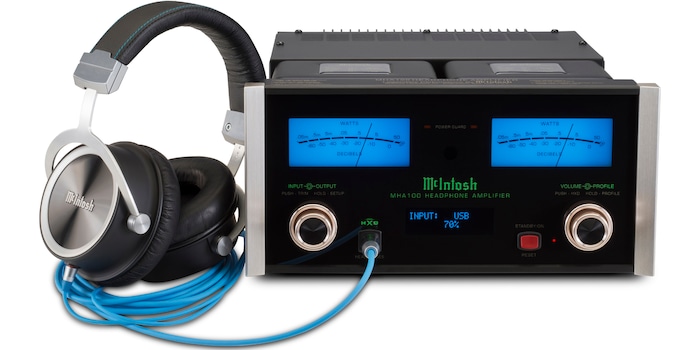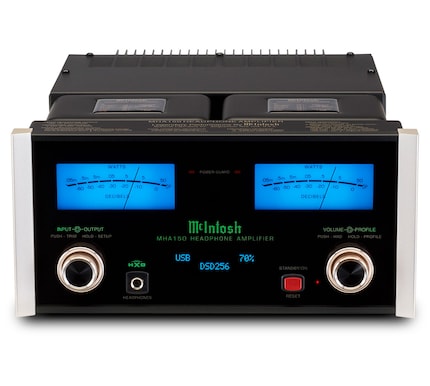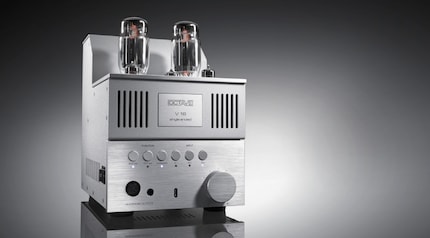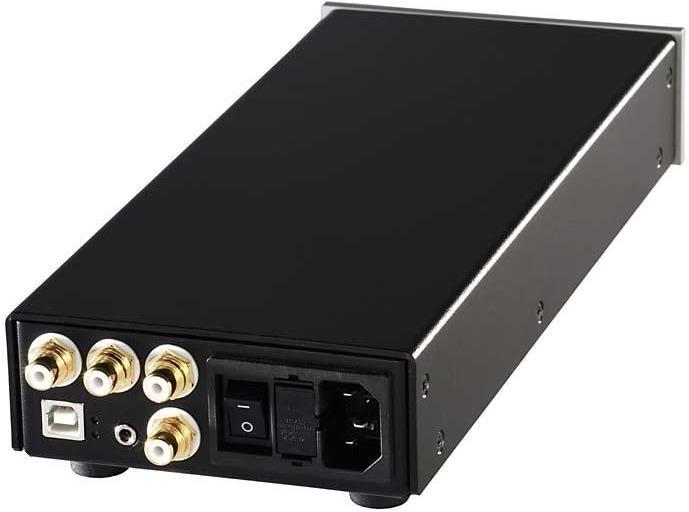

When and why you need headphone amplifiers
The better your headphones are, the more they need the right power supply. Headphone amplifiers can be just what you’re looking for. They deliver more powerful sound, which is beneficial for your ears in many ways.
Headphones can never be good enough; any ear specialist will confirm bad headphones harm your ears. And once the damage is done to the outer or inner part of your ear, you’ve pretty much had it.
For the most part, it’s not the volume itself that wreaks havoc with the sensitive cells in your inner ear. Unless, of course, you’re constantly subjected to hammer drill levels – in which case you’d expect significant and rapid damage. But in some situations, volume is a more complicated matter. Distortion is one of the main things that can make subjectively experienced volume unbearable. Meanwhile, distortion-free, clear sounds can still be pleasant at very high levels. As a rule of thumb, painful levels are more dangerous than pleasant ones.
Why do you need headphone amplifiers in the first place?
And that’s where headphone amplifiers come in. Whether you can see them or not, they’re in every device that has a headphone jack (3.5 or 6.3 mm). The bad news is that in most smartphones, tablets and computers, the amplifiers in the jacks are cheap and shoddy. They just use a thrifty operational amplifier that won’t have set the company back more than 30 centimes. Why? Because manufacturers want to cut costs and they want their mobile devices to use as little power as possible.
If you don’t listen to loud music, struggle to listen to loud music or don’t listen to loud music for long periods of time because swollen, imprecise bass; unintelligible voice audio and hissing or hollow treble quite simply get on your nerves you’re best to buy a good set of headphones. And then give immediate thought to headphone amplifiers – ones that are appropriate for their intended use.
Mobile entertainment
I hardly need to state the obvious: any extraneous wires or bits and bobs flapping about next to your smartphone just get on your nerves when you’re exercising. The prerequisite for listening outdoors is something called low impedance headphones. They don’t zap as much energy from supply batteries and rechargeable batteries. The packaging and description quotes values between 10 and 50 ohms.
I hardly need to state the obvious: any extraneous wires or bits and bobs flapping about next to your smartphone just get on your nerves when you’re exercising. The prerequisite for listening outdoors is something called low impedance headphones. They don’t zap as much energy from supply batteries and rechargeable batteries. The packaging and description quotes values between 10 and 50 ohms.
The downside is always having this extra «burden» and permanently needing to have another battery as fully charged as possible. Don’t expect earth-shattering advances in sound quality. But, let’s be honest, if you’re always on the move, you might not need the most high-fidelity playback as background noise for your huffing and puffing.
When you’re in the gym and spending more time pumping iron, tapping your feet or sitting rather than scampering around, you’ll definitely need a more powerful battery or rechargeable battery-operated headphone amplifier. You’ll obviously still want it to be small enough to slip into your sports bag or sneak under the sweaty towel you’re dragging from one exercise device to the next. This is another scenario where music serves purely as motivation. As with jogging headphones, the most important thing is creating a more gentle massage for the eardrums.
If, however, you’re someone who spends a lot of time on the tram or train, you may be able to to stow a slightly more bulky headphone amplifier in your briefcase or school bag. In this instance, it’s definitely worth opting for strong, high-quality amps, as you want any background noise to be drowned out completely distortion-free.
Maybe you’ve already snagged a pair of noise cancelling headphones. They’re handy things that block out the hubbub going on around you. And you’re free to turn up the quality even when you’re using headphone amplifiers.
Let me give you an example. The iDSD from iFi Audio features a high-quality D/A converter that also converts DSD signals. In addition, it comes with a 3.5 and 6.3 mm jack connector.

Headphones for the computer
If you usually listen to music via tablet, notebook or mostly on the computer with headphones (whether from your hard drive or streaming service), you can upgrade the sound in two places in one fell swoop.
The sound in digital devices is saved and processed digitally, but humans can still only hear analogue. That’s why these devices need a digital analogue converter or DAC for short. In computers, these can be found on the audio card – and unfortunately, in most cases they’re pretty meagre.
Conveniently, many headphone amplifiers come with a DAC. If you budget about 200 Swiss francs, you’ll get better quality from your converter than you would normally from a computer. It all starts with the fact it has its own energy supply for the electronics. In a computer, on the other hand, the poor little chip has to share the juice with dozens of other parts. In other words, if you want the best possible sound from your computer, check out DAC/headphone amplifier combinations. There are plenty of them on the market.
An example of a tried and tested headphone amplifier-DAC at the higher end of the quality scale that’s still good value for money is the Oehlbach XXL DAC Ultra.
But you should always check beforehand that both sides have the right ports. If you stream in high resolution, you’ll also want to check whether the DAC can process the relevant high data rates. Having said that, most external converters can even cope with rates with a 24 bit word size and 192 kHz sampling frequency thanks to standard ICs that have been properly equipped for quite some time now. For non-techies out there, that means you’re getting about a thousand times as much data per second as with a CD.
Headphones and different systems
Are you still stuck on old fashioned CDs or even LPs? Perhaps you prefer to play high resolution files on a high-end HiFi. If that’s the case you probably use the headphone outlet on the central amplifier or CD player. But in the affordable segment, headphone outlets are considered the developer’s lowly invention, even when it comes to good (complete) amplifiers. Their controllers are more than happy to cut these outlets from the device. That’s why a run-of-the-mill operational amplifier often has to do the work behind the jack socket.
Once you have a really good set of headphones, you’ll obviously want the best power supply for it. We’ll leave out the the exception of electrostatic headphones that are popular at the high end of the scale, as they’ve been built with their own power supply. In terms of standard electrodynamic headphones, the HiFi market offers solutions starting at 150 Swiss francs all the way up to – wait for it – 10,000 Swiss francs.
What they all have in common is they can also easily deliver enough juice to high-impedance headphones (from 200 to 600 ohms and above). Many models even offer two jacks so you can listen along with someone else and both use your own headphones. Lehmann Audio’s Black Cube Linear is just one example of this.
You can even get headphone amplifiers with individual volume controls for the second set of earphones. Here’s how it works in terms of jacks: to loop a separate headphone amplifier into a HiFi system properly, you need a fixed output at the (pre-)amplifier. That’s normally the tape out – in the past this would have meant connecting up the cassette recorder or tape machine.
It’s here you’ll find a fixed level that’s independent of the amplifier’s volume control and that in turn provides the input for the headphone amplifier. Incidentally, the cable length can be up to three metres without there being any problems. If you’re OK with the cabling, you can place the headphone amplifiers right next to where you want to listen. While there are wireless solutions, I’m yet to hear of any satisfactory options at the top end of the market.
You can then control the monitoring volume on the headphone amplifier. Some models still offer gems such as tone control, which can be really useful depending on your music taste and sound preferences. These days, a lot of high-end headphones are more «mild» and adapted for really low frequencies. If you prefer a peppering of high notes and a leaner bass, you can go ahead and adjust it.
Top of the range
Special circuit tricks such as Crossfeed are a real treat. The problem with headphones in general is that the division of left and right is particularly pronounced. When you’re using speakers and, of course, in real life, you hear sound from the left in your right ear with minimal time delay and vice versa.
Many consumers complain that when they use headphones they don’t get the feeling of having a stage in front of them. They feel like mixed signals in the middle are playing in the centre of their head. In pop music this is usually the vocal. Crossfeed delivers signals to the left and right channel and vice versa with minimal delay and dampened where necessary.
Depending on how well the circuit is designed, it can sound astonishingly good and spacious. The manufacturer McIntosh installed the effect in its first generation, even in its full amplifiers. But sure enough, these premium amps from the US cost an arm and a leg.

But even «pure» headphone amplifiers can get really expensive. Whether a headphone amplifier uses transistors or tubes is not a quality criterion. Nevertheless, tubes can give a more pleasant headphone sound with their «indulgent» distortion characteristics in a higher price range.
When it comes to sheer performance yield, tubes are mostly inferior to semiconductors. However, headphones need much less voltage and current than loudspeakers. That being said, the circuit should tame the hissing of the receiver, which is particularly annoying over headphones.
It’s possible but it will cost you. A cheap Chinese tube doesn’t guarantee good sound. So beware of the supposedly cheap pseudo premium options. At the other end of the spectrum you’ve got the German high-quality manufacturer Octave. They build the V 16, which is considered one of the best headphone amplifiers in the world. In fact, it’s so good that it became a mainstream full amplifier while it was being developed, despite its low power. This bit of kit will set you back 10,000 Swiss francs – and it can’t even claim top spot for the best in the world.

In top-of-the-range models, you have other connector options. I started out by describing the 3.5 and 6.3 mm connector or jack as standard. You’ll see a trisection on the connector shaft: one segment directs the + signal for the left; the second for the right and the third is for the total – mass, which also serves as a shield.
To ensure there is something for various needs, there are other alternatives for high-end headphones. There are some with two separate cables with headphone jacks; others with so-called XLR connectors or those with a cable that features a quadripole XLR connector. Symmetrical connection drives normal + down one wire and inverted, 180 degrees rotated signal down the other. When the signal comes together again at the headphone membrane, any interference cancels itself out.
Confusing? Yeah, I know. In plain terms it just means the signal remains flawless from start to finish.
Verdict
What’s more important and less expensive is simply knowing you can do your ears the world of good for relatively little money. For one thing, you can grab yourself some decent headphones. You can also combine them with a headphone amplifier – I promise your ears will thank you. Every centime you invest in this sensitive organ of perception will pay off for life.
I have been a journalist in the audio industry for over 30 years. I have a reputation as an avid music lover, a die-hard analog fan and an uncompromising critic of speakers. This surely has something to do with my lamentable attempts to play violin and drums beyond amateur status. For a while I lived and worked in Switzerland, my favorite country, where I love to return.
Interesting facts about products, behind-the-scenes looks at manufacturers and deep-dives on interesting people.
Show all
